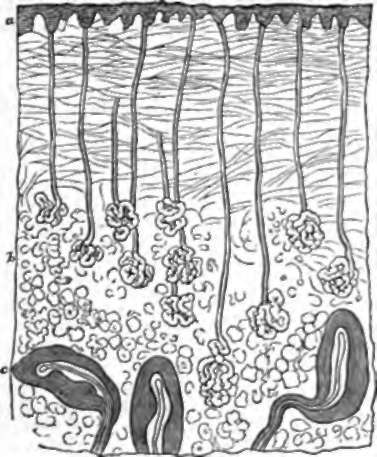44. The Glands Of The Skin
Description
This section is from the book "Animal Physiology: The Structure And Functions Of The Human Body", by John Cleland. Also available from Amazon: Animal Physiology, the Structure and Functions of the Human Body.
44. The Glands Of The Skin
The Glands Of The Skin are of two descriptions, the sudoriparous and the sebaceous.
The sudoriparous, or sweat glands, are in great numbers all over the body. In the palm of the hand there are as many as 2500 in every square inch of skin, but in the lower limbs and back there have been estimated to be not more than 600 in the square inch. On the palm, particularly when it is warm and slightly moist, the orifices of these glands may be easily seen with a simple pocket lens arranged in a row on every ridge. Each gland consists of a tubule, the secreting part of which is coiled up Into a ball about 1/50 or 1/100 inch in diameter, imbedded in the subcutaneous tissue, and supplied freely with blood-vessels, while the duct passes vertically up through the corium. Sometimes there are two tubes in one coil, uniting to form one duct. In the palm of the hand and the sole of the foot, where the epidermis is thick, the sudoriparous ducts, in passing through the horny layer, are thrown into a fine spiral like a cork-screw, which may be accounted for thus: the ducts in the deep part of the cuticle are lined with horny epithelium, which is incapable of contraction, while round about them are growing epithelial cells of the rete mucosum, which, as they approach the surface, in process of conversion into the horny layer, become flattened; the horny wall of the duct, as it is carried to the surface with the structures in which it is imbedded, having therefore to be accommodated in a shorter vertical depth than it occupied at first, is pressed by the shrinking structures round it into an oblique position, and the regular continuance of this process gives rise to a spiral.

Fig. 38. Sweat Glands and Pacinian Corpuscles, a, Papillary surface of corium; b, secreting portions of the sweat glands; c, corpuscles of Pacini.
The sebaceous glands (fig. 41) are for the most part connected with hairs; and large hairs have usually several of them opening into the necks of their follicles, but frequently it happens, particularly in the face, that a very large sebaceous gland opens into the neck of the follicle of a very small hair, showing that these glands not only serve to lubricate the hair, but the integument as well. The sebaceous glands consist of one or more small groups of saccules opening into a common duct, lined with epithelium, and filled with oily matter.
Continue to:
